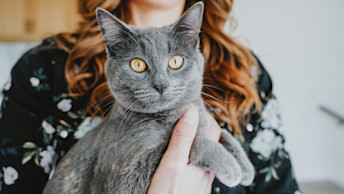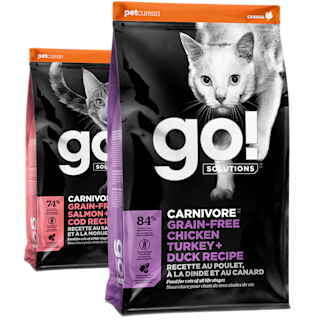May 31, 2021
What Nutrients Does My Cat Need?

It's no secret that people love their cats. Today, cats are considered the world's most popular pet.1 In 2016, the American Pet Products Association (APPA) National Pet Owner Survey estimated 94.2 million cats and 89.7 million dogs in the United States alone.2 However, when compared to dogs, cats have some unique nutritional and dietary requirements that require special attention. These requirements stem from cat's evolution due to its strictly carnivorous ancestors and the nutrients supplied to them through animal tissue consumption.
Today, the average house cat lives a much more inactive lifestyle and can thrive on various diet types.3 Therefore, when it comes to formulating diets for cats, extra attention is required to a few essential nutrients that must be included in sufficient amounts to maintain optimal health. The unique nutritional requirements of cats are related to their protein, taurine, arginine, vitamin A, vitamin D, niacin, and arachidonic acid requirements.4
Protein and amino acids
From a nutrient perspective, cats don't necessarily require an ultra-high protein diet, but they have higher requirements for amino acids from dietary protein than dogs. Amino acids are the building blocks of protein, and certain amino acids can be produced by the animal (i.e. non-essential amino acids). In contrast, others can only be obtained from the diet (i.e. essential amino acids). Cats require ten non-essential amino acids and eleven essential amino acids. Additionally, they also have a unique requirement for the amino acid taurine and a need for significantly increased arginine levels compared to dogs.

Recommended Solutions
Carnivore Recipes for Cats
Up to 99% of protein from premium-quality animal sources
Carnivore
Arginine
Research has shown that cats are susceptible to diets lacking arginine. A diet deficient in arginine has been shown to quickly result in cats' severe health symptoms due to increased blood ammonia levels.5 Arginine is necessary for ammonia detoxification by converting it to urea for excretion in the urine. During a deficiency of dietary arginine, ammonia builds up and results in ammonia toxicity within the cat. Therefore, cats can't synthesize the precursor's ornithine and citrulline, both needed for arginine production. However, arginine is abundant in animal protein, and as a result, cats have evolved to be reliant on it from a dietary source.
Taurine
Similar to arginine, taurine is an amino acid that is readily found in meat protein. Dogs and other mammals can produce taurine through the oxidation of sulphur amino acids, cysteine and methionine. For cats, the enzymes necessary for these pathways have deficient activity levels, and as such, cats are limited in their production of taurine. Dietary taurine is required in the diet for cardiovascular health, bile formation, retinal health, and proper growth and development in kittens.6 Symptoms of taurine deficiency include retinal degeneration and an enlarged heart, also known as dilated cardiomyopathy.
Vitamins
Vitamins are necessary for nourishing your cat - whether kitten, adult or senior, for overall health maintenance. Vitamins can be classified into one of two groups: fat-soluble or water-soluble. Fat-soluble vitamins can be stored in fatty tissues, whereas water-soluble vitamins cannot be stored and are excreted in the urine if consumed in excess.
Vitamin D
Vitamin D is a fat-soluble vitamin necessary for bone health and development. Humans can produce vitamin D from exposure to sunlight or obtain the vitamin through food sources. Cats, however, are unable to synthesize vitamin D and depend solely on dietary sources. A study on the exposure of both hairless and non-hairless kittens to direct sunlight demonstrated this lack of endogenous production.7 When the kittens were placed on a diet deficient in vitamin D, they showed the same rate of vitamin D decline as kittens receiving the same diet but housed indoors. Research has since found that cats' skin has a low concentration of the precursor 7-dehydrocholesterol, necessary for the synthesis of vitamin D. Additionally, synthesis is prevented by the high activity of the enzyme responsible for breaking down this precursor substrate and converting it into cholesterol. Historically, cats obtained their vitamin D from the liver of prey, such as birds and rodents. Today, commercial cat diets are typically supplemented with vitamin D to ensure adequate intake.
Vitamin A
Just like vitamin D, vitamin A is also a fat-soluble vitamin. Vitamin A is necessary for maintaining normal vision, immune function, as well as the growth and development of cats. As vitamin A is naturally abundant in animal tissue, cats haven’t evolved to synthesize vitamin A in the same way as herbivores and omnivores. Plants produce β-carotene, a precursor for the synthesis of vitamin A by the body. Unlike omnivores and herbivores, cats appear to lack the enzyme necessary to convert β-carotene into retinol. It’s assumed that cats have not evolved to synthesize vitamin A as meat proteins are low in carotenoids. The liver of prey is rich in vitamin A, so the conversion pathway would not be considered metabolically necessary or beneficial in energy efficiency.
Niacin
Niacin is a water-soluble vitamin that is essential for energy metabolism. Cats possess all the necessary enzymes and pathways for the production of niacin from the amino acid tryptophan. Tryptophan can be metabolized to produce acetyl coenzyme A (acetyl CoA) and carbon dioxide (CO2),or nicotinamide adenine dinucleotide (NAD; the active form of niacin). In cats, the enzyme responsible for catalyzing the conversion of tryptophan to acetyl CoA and CO2 has a very high activity, so niacin is broken down faster than produced.8 However, cats are well supplied with niacin from the NAD, and NADP is found in large concentrations in animal tissues. On average, cats require about 2.4 times the amount of niacin than dogs.
Unique Fatty Acids
Cats can’t make arachidonic acid and require a dietary source of this omega-6 fatty acid, especially during the demanding life stages of growth, gestation and lactation. Arachidonic acid is found in an abundant supply in animal tissues, especially the organs. However, it's not present in plants. Omnivores, and herbivores can synthesize arachidonic acid from linoleic acid, another type of omega-6 fatty acid. Arachidonic acid is a necessary component of cell membranes and plays a role in cell signaling and inflammation.
The unique dietary requirements of cats stem from their evolution as strictly carnivorous creatures. Cats aren’t able to obtain all necessary nutrients from plant products alone without appropriate supplementation. Therefore, diets containing animal tissue can more easily meet their taurine requirements, arginine, vitamin A, vitamin D, niacin, and arachidonic acid.
Springer J. The 2017-2018 APPA National Pet Owners Survey Debut. http://americanpetproducts.org/Uploads/MemServices/GPE2017_NPOS_Seminar.pdf Accessed January 25 2018.
Bradshaw B. 2013. Dogs we understand; cats are mysterious, even though they are
the most popular pet. https://www.washingtonpost.com/national/health-science/dogs-we-understand-cats-are-mysterious-even-though-they-are-the-most-popular-pet/2013/10/14/2c59c6b0-26ca-11e3-ad0d-b7c8d2a594b9_story.html?utm_term=.08883fbb6a39 Accessed Jan 25 2018.Verbrugghe A, et al. Veterinary Sciences 2017;4:55.
Morris JG. Nutr Res Rev 2002;15:153-168.
Rogers QR, et al. J Nutr 1979;109:718-723.
Knopf K, et al. J Nutr 1978;108:773-778.
Morris JG. J Nutr 1999;129:903-908.
Ikeda M, et al. J Biol Chem 1965;240:1395-1401.
Authors



